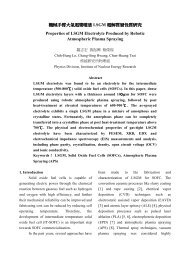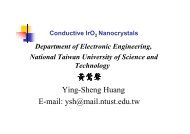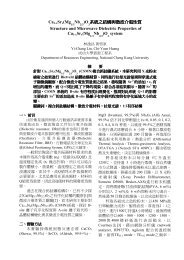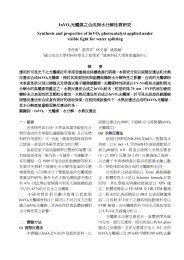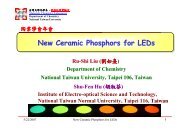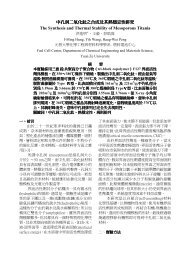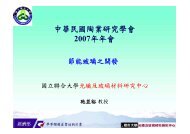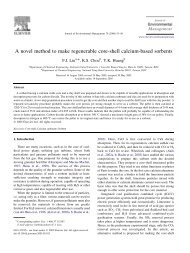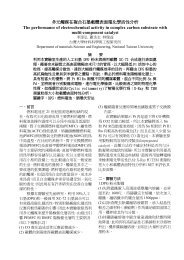Fabrication and sint..
Fabrication and sint..
Fabrication and sint..
You also want an ePaper? Increase the reach of your titles
YUMPU automatically turns print PDFs into web optimized ePapers that Google loves.
INSTITUTE OF PHYSICS PUBLISHING NANOTECHNOLOGY<br />
Nanotechnology 16 (2005) 779–784 doi:10.1088/0957-4484/16/6/027<br />
<strong>Fabrication</strong> <strong>and</strong> <strong>sint</strong>ering effect on the<br />
morphologies <strong>and</strong> conductivity of nano-Ag<br />
particle films by the spin coating method<br />
Kan-Sen Chou 1 ,Kuo-Cheng Huang <strong>and</strong> Hsien-Hsuen Lee<br />
Department of Chemical Engineering, National Tsing Hua University, Hsinchu 30013,<br />
Taiwan<br />
E-mail: kschou@che.nthu.edu.tw<br />
Received 12 November 2004, in final form 3 March 2005<br />
Published 5 April 2005<br />
Online at stacks.iop.org/Nano/16/779<br />
Abstract<br />
By adjusting the rotating speed <strong>and</strong> colloidal concentration in the spin<br />
coating of silver nanoparticles onto a glass substrate, the coating density<br />
could be varied from 1.5 × 10 −6 to 1.1 × 10 −4 gcm −2 ,orinotherwords<br />
from a dispersed distribution to multi-layered close packed films. The<br />
coating density was found to be proportional to the volume fraction of silver<br />
colloids <strong>and</strong> inversely to the rotating speed to the 0.442 power. The<br />
multi-layered films were further investigated for <strong>sint</strong>ering behaviour. Our<br />
results indicated that the film started to exhibit a noticeable <strong>sint</strong>ering effect<br />
at about 100 ◦ C, <strong>and</strong> at the same time it became electrically conductive. As<br />
the treatment temperature increased further, the film resistivity reached a<br />
minimum value at 250 ◦ C<strong>and</strong> finally became insulating again when the<br />
temperature was over 400 ◦ C due to silver coalescence into large particles<br />
<strong>and</strong>breaking up of the conductive paths. Smaller silver nanoparticles,<br />
however, would exhibit a similar phenomenon but at lower temperatures.<br />
1. Introduction<br />
In recent years, nanotechnology has risen in importance in<br />
various fields due to the special characteristics of nanomaterials<br />
or nanostructures. For example, metal nanoparticles can<br />
be used as the catalysts to grow nanowires. Transitionmetal<br />
nanoparticles are also useful in fabricating highdensity<br />
magnetic recording media [1]. Besides, nanoparticles<br />
possessing surface plasma resonance can also be used as<br />
biosensors [2]. In the application of nanoparticles, one of<br />
the fundamental issues is how to distribute nanoparticles<br />
uniformly on the substrate with precise control of density [1].<br />
For carbon nanotube growth, nickel nanoparticles are used as<br />
the catalysts <strong>and</strong> a certain distance is needed to prevent the<br />
shielding effect between these grown carbon nanotubes [3]<br />
while maintaining sufficient density. However, in other<br />
applications such as high-density magnetic recording media,<br />
close packing or even a multi-layered structure is required [4].<br />
There are several methods proposed for dispersing<br />
nanoparticles on a substrate. In many studies, the self-<br />
1 Author to whom any correspondence should be addressed.<br />
assembly technique was employed utilizing the chemical<br />
interaction between nanoparticles <strong>and</strong> the substrate surface.<br />
For example, organic molecules containing thiol (–SH) or<br />
amine (–NH2) can be adsorbed on the gold surface <strong>and</strong><br />
form a well organized self-assembly monolayer on the<br />
substrate [5]. Another popular method is lithography, which<br />
is able to produce a well ordered pattern <strong>and</strong> accurately<br />
controlled density. However, this method requires a lot<br />
of processing procedures <strong>and</strong> is relatively complicated <strong>and</strong><br />
expensive. Therefore, a simpler <strong>and</strong> cheaper method by the<br />
traditional spin coating has recently been proposed [1, 4–<br />
7] as an alternative. By this technique, different coating<br />
densities could be achieved by controlling the rotating speed<br />
<strong>and</strong> colloidal concentration. Nevertheless, in the literature<br />
very few systematic studies on the effects of the processing<br />
(coating) parameters of nanoparticles had been reported. In<br />
this work, due to our ability to obtain well dispersed nano-silver<br />
colloids in high concentrations,thecoating behaviour of nanosilver<br />
particles are therefore investigated over an extensive<br />
range of Ag concentrations <strong>and</strong> rotating speeds to obtain Ag<br />
coatings having different densities. Subsequently, an empirical<br />
equation was determined to correlate coating density with Ag<br />
0957-4484/05/060779+06$30.00 © 2005 IOP Publishing Ltd Printed in the UK 779
K-S Chou et al<br />
concentration <strong>and</strong> rotating speed. In addition, the <strong>sint</strong>ering<br />
of coated Ag colloids <strong>and</strong> its electrical resistivity are also<br />
investigated as a function of heating temperature.<br />
2. Experimental details<br />
2.1. Synthesis of Ag nanoparticles<br />
Ag nanoparticles were synthesized by the chemical reduction<br />
method; silver ion was reduced by formaldehyde under the<br />
presence of protecting agent, polyvinyl pyrrolidone (PVP;<br />
MW = 50 000, Acros Organics, USA) [8, 9]. The silver<br />
colloid was then washed to remove excess protecting agent<br />
<strong>and</strong> then re-dispersed in de-ionized water to obtain the working<br />
suspension. Details of experimental procedure can be found<br />
elsewhere [8]. The actual silver content in the suspension<br />
was determined by first dissolving it with nitric acid <strong>and</strong><br />
then by atomic absorption spectroscopy (AAS; SpectraAA-30,<br />
Varian, USA) after appropriate dilution. Quantities of residual<br />
PVP were estimated from results of thermal gravimetric<br />
analysis <strong>and</strong> morphology of silver colloids was observed by<br />
transmission electron microscopy (TEM, TECNAI 20, Philips,<br />
The Netherl<strong>and</strong>s).<br />
2.2. Spin coating process<br />
Aglassslide (cut to 3 cm × 3cm,thickness 1–1.2 mm,<br />
FEA company, Taiwan) was first immersed in HNO3 solution<br />
(0.01 N, EP grade, Union Chemical, Taiwan) <strong>and</strong> then moved<br />
into acetone (EP grade, Union Chemical, Taiwan) in order to<br />
remove the particles <strong>and</strong> organic contaminants on the surface.<br />
After cleaning, the slide was air-dried at room temperature.<br />
In the coating process, 0.15 ml Ag colloid of a chosen<br />
concentration was placed on the slide <strong>and</strong> dispersed uniformly<br />
to the whole surface by a tip. Then the slide was rotated by the<br />
spinner (PM-490, Synrex, Taiwan) at different speeds for 30 s.<br />
The coated slide was dried in the air at room temperature. By<br />
adjusting the Ag colloid concentration, the Ag deposition on<br />
theslidecould be controlled from a monolayer well dispersed<br />
state, to monolayer close packing <strong>and</strong> finally to multi-layered<br />
structures.<br />
2.3. Coating density analysis<br />
Twomethods were utilized to determine the coating density<br />
of silver, namely the AAS method <strong>and</strong> image analysis of<br />
microscopic photos. For the AAS method, Ag nanoparticles<br />
deposited on the glass slide were dissolved by HNO3 solution<br />
(0.1 N, 10 ml) <strong>and</strong> subsequently analysed by atomic absorption<br />
spectroscopy (AAS) to determine the Ag quantity. The coating<br />
density could then be calculated by dividing the Ag quantity by<br />
the slide area. This number represented an overall average. As<br />
for the image analysis method, software (Image J, NIH, USA)<br />
was used to determine the number <strong>and</strong> diameter distribution<br />
of coated Ag nanoparticles within a few selected areas, <strong>and</strong><br />
thus coating density could be directly estimated from the SEM<br />
photograph. This number on the other h<strong>and</strong> represented a very<br />
small local region <strong>and</strong> was applied to dispersed distributions<br />
only. Results from both methods were compared to confirm<br />
the validity of the data <strong>and</strong> also to express the uniformity of<br />
the coating.<br />
780<br />
Figure 1. TEM image of silver nanoparticles.<br />
The thickness of multi-layered Ag coating was also<br />
measured by the microscopy (SEM, S-4700I, Hitachi, Japan).<br />
The roughness of the surface was determined by scanning<br />
probe microscopy (SPM, NanoScope E, Digital Instruments,<br />
USA).<br />
2.4. Sintering <strong>and</strong> resistivity measurements<br />
Ag coated glass slides (as a film of 82 nm thickness), using<br />
Ag suspension at 2.42 vol% (20.7 wt%) <strong>and</strong> rotating speed of<br />
6000 rpm, were heat-treated in air at various temperatures. The<br />
sample was heated to the desired temperature in 30 min <strong>and</strong><br />
kept at that temperature for another 30 min. Then the slide was<br />
naturally cooled in the oven until the temperature was below<br />
50 ◦ C. The surface morphology of the slide was observed<br />
by SEM <strong>and</strong> the resistivity was estimated by the four-probe<br />
method (C4S-54/5S, Cascade Microtech, USA).<br />
3. Results <strong>and</strong> discussion<br />
3.1. Ag nanoparticles characteristics<br />
The Ag nanoparticles used for the coating study were shown<br />
in figure 1. The average size was about 46 nm, but it also<br />
contained a few large particles of about 100 nm. The silver<br />
suspension exhibited yellow colour <strong>and</strong> showed a UV–vis<br />
absorption peak at 410 nm. The residual PVP quantity was<br />
estimated around 0.05 g/g Agforthis batch of sample.<br />
3.2. Coating morphology<br />
Figure 2 shows the Ag deposition from dispersed distribution<br />
to multi-layered close packing obtained by varying Ag colloid<br />
concentration at a constant rotating speed (6000 rpm). At<br />
low Agcolloid concentrations, the nanoparticles were well<br />
dispersed <strong>and</strong> separated. When the concentration was<br />
increased, the nanoparticles became gradually aggregated in<br />
the micro-scale but still remained roughly uniform on the<br />
macro-scale. Conceivably, under this situation, the liquid film<br />
might break into small droplets during the evaporation stage
<strong>Fabrication</strong> <strong>and</strong> <strong>sint</strong>ering effect on the morphologies <strong>and</strong> conductivity of nano-Ag particle films by the spin coating method<br />
0.15 vol.% 0.52 vol.%<br />
0.70 vol.% 1.33 vol.%<br />
1.85 vol.% 2.42 vol.%<br />
Figure 2. SEM photographs of Ag nanoparticle coating of different concentrations at 6000 rpm for 30 s.<br />
<strong>and</strong> hence caused the aggregation of particles within that small<br />
region. Finally, when the concentration increased further, the<br />
nano-silver particles packed to a multi-layered structure with<br />
ashiny surface, suggesting a relatively smooth surface. A<br />
representative SPM image is shown in figure 3(a), <strong>and</strong> the<br />
statistical mean roughness of the surface is about 5.5 nm, while<br />
the maximum height within this area is about 47.5 nm. This<br />
result is consistent with the SEM observations. For a multilayered<br />
coating, its coating density could also be determined<br />
from the thickness data by assuming close packing of particles,<br />
which was in general agreement with results from the AAS<br />
method.<br />
3.3. Parameters affecting the coating density<br />
Next shown in figure 4 is the comparison of results from<br />
both AAS <strong>and</strong> image analysis for low-coating-density cases,<br />
showingreasonable agreement. It therefore suggested that the<br />
coating obtained in thiswork was uniform. As a result, the<br />
data from the micro-scale (image analysis) agreed well with<br />
those from the macro-scale (AAS method).<br />
Shown in figure 5 are the correlations between coating<br />
density <strong>and</strong> Ag colloid concentration at different rotating<br />
speeds. In theory, the coating density is proportional to the<br />
Ag colloid concentration <strong>and</strong> the thickness of the Ag colloid<br />
liquid film during the spinning procedure. As for the film<br />
thickness, it is mainly decided by two factors: liquid viscosity<br />
<strong>and</strong> rotating speed. In our case, the viscosity did not change<br />
much with silver concentration <strong>and</strong> hence could be taken as<br />
constant. Therefore, the coating density could be controlled<br />
by varying Ag colloid concentration <strong>and</strong> rotating speed in our<br />
experiments, as indicated in figure 5.<br />
Because the coating density was mainly affected by the Ag<br />
colloid concentration <strong>and</strong> the rotating speed, the relationship<br />
781
K-S Chou et al<br />
Figure 3. (a) SPM image of the surface of Ag coating. The mean<br />
roughness of the surface is 5.5 nm. (b) Side-view of Ag coating<br />
(coating condition: Ag concentration 2.42 vol% <strong>and</strong> rotating speed<br />
6000 rpm). The top view of this coating is shown in figure 2.<br />
Image analysis<br />
1e-5<br />
8e-6<br />
6e-6<br />
4e-6<br />
2e-6<br />
0<br />
Coating density correlation<br />
R 2 = 0.80<br />
0 1e-6 2e-6 3e-6<br />
AAS method<br />
4e-6 5e-6 6e-6<br />
Figure 4. Correlations between AAS method <strong>and</strong> image analysis for<br />
the determination of coating density (under low-coating-density<br />
conditions).<br />
could be represented as<br />
D = αC β ω γ<br />
where D (g cm −2 )isthecoating density, C is the Ag colloid<br />
concentration (expressed asavolumefraction), <strong>and</strong> ω (rpm)<br />
is the rotating speed, with α, β <strong>and</strong> γ being the empirical<br />
constants. Since our results in figure 5 exhibited a linear<br />
782<br />
(a)<br />
(b)<br />
(1)<br />
Coating density (g/cm 2 )<br />
1.4e-4<br />
1.2e-4<br />
1.0e-4<br />
8.0e-5<br />
6.0e-5<br />
4.0e-5<br />
2.0e-5<br />
0.0<br />
-2.0e-5<br />
6000 rpm R 2 = 0.98<br />
4500 rpm R 2 = 0.99<br />
3000 rpm R 2 = 0.99<br />
1500 rpm R 2 = 0.99<br />
0.0 0.5 1.0 1.5 2.0 2.5 3.0<br />
Ag colloid concentration (vol.%)<br />
Figure 5. Coating density as a function of Ag colloid concentration<br />
at different rotating speeds.<br />
relationship to Ag concentration, <strong>and</strong> hence β was taken as<br />
unity. The final result was as follows (with R 2 = 0.97):<br />
D = 0.1265 × Cω −0.442 . (2)<br />
From spin-coating theory, if not considering the effect<br />
of evaporation, the thickness of liquid film is inversely<br />
proportional to the rotating speed, i.e., γ =−1[10]. However,<br />
when the evaporation is considered, the value of γ would be<br />
close to −0.5 depending on the volatility <strong>and</strong> concentration<br />
of solvent [11]. In this study, γ was approximately −0.44,<br />
suggesting that the evaporation must be important here.<br />
3.4. Sintering of the coated Ag nanoparticles<br />
The coated Ag nanoparticles (with a thickness of about 82 nm)<br />
were heated in an oven at different temperatures, <strong>and</strong> the<br />
resulting morphologies are shown in figure 6. It can be noted<br />
that Ag nanoparticles began to exhibit the <strong>sint</strong>ering effect at<br />
100 ◦ Corprobably even below this temperature, because the<br />
deposited particles started to exhibit conductivity after 70 ◦ C<br />
treatment. As the temperature increased, the Ag nanoparticles<br />
became coalesced together into a porous film due to the high<br />
mobility of silver atoms in these nanoparticles. When the<br />
temperature increased more, the voids of the porous film<br />
grew, <strong>and</strong> eventually, above 400 ◦ C, the silver film shrank<br />
into numerous large Ag particles <strong>and</strong> the conducting path was<br />
broken. Corresponding data for electrical resistivity are shown<br />
in figure 7.<br />
Before the heat treatment, the resistivity of deposited<br />
Ag particles was extremely large <strong>and</strong> could be considered<br />
as an insulated material. Presumably, at this stage, the Ag<br />
particles were still covered with a layer of the protective agent<br />
(PVP molecules) <strong>and</strong> were barely in contact with each other.<br />
When the heating temperature was 70 ◦ C, which might be<br />
sufficient for PVP molecules to move away from the particle<br />
surface to coalescence together <strong>and</strong> separate from the particles,<br />
the silver particles then touched each other <strong>and</strong> conducting<br />
electricity. Further heating would enlarge the contact area<br />
between particles <strong>and</strong> thus lower the resistivity. Due to the<br />
high activity of nanoparticles, the film resistivity reached a<br />
minimum value of 2.4 × 10 −5 cm after 250 ◦ Ctreatment as<br />
<strong>sint</strong>ering progressed. Further increase of heating temperature
<strong>Fabrication</strong> <strong>and</strong> <strong>sint</strong>ering effect on the morphologies <strong>and</strong> conductivity of nano-Ag particle films by the spin coating method<br />
(a) 100 o C (b) 200 o C<br />
(c) 250 o C (d) 300 o C<br />
(e) 350 o C (f) 400 o C<br />
Figure 6. SEM morphologies after heat treatment at different temperatures for 30 min: (a) 100 ◦ C; (b) 200 ◦ C; (c) 250 ◦ C; (d) 300 ◦ C;<br />
(e) 350 ◦ C; (f) 400 ◦ C.<br />
would continue the densification process of <strong>sint</strong>ering by<br />
decreasing the surface area <strong>and</strong> thus increasing particle size.<br />
At the same time, the voids within the film also combined<br />
into large pores. Consequently, the conductive silver networks<br />
were gradually broken, <strong>and</strong> the resistivity started to increase.<br />
At last, all the silver particles <strong>sint</strong>ered into larger <strong>and</strong> separated<br />
ones, <strong>and</strong> the film became insulating again.<br />
Also included in figure 7 are the results from another batch<br />
of nano-silver particles for comparison. The average size of<br />
thesecond-batch particles is about 37 nm (versus 46 nm of the<br />
first batch); besides, the distribution is narrower in the second<br />
batch. As a result, the film reached a minimum resistivity after<br />
200 ◦ Cheat treatment <strong>and</strong> lost conductivity after 300 ◦ C. Both<br />
temperatures were lower than the previous case, indicating the<br />
size effect of these silver particles.<br />
In view of the very low resistivities developed in these<br />
films <strong>and</strong> easy h<strong>and</strong>ling of the suspension, there is a good<br />
chance to successfully apply the inkjet printing technique to<br />
these silver nanoparticles for the manufacture of conducting<br />
lines. Also, the low-temperature treatment would enable<br />
the use of alternative polymeric substrates. However, more<br />
research is needed for their development.<br />
4. Conclusions<br />
In this work, systematic studies on the effect of Ag colloid<br />
concentration <strong>and</strong> the rotating speed on the coating density<br />
were made. It varied from a dispersed distribution to a<br />
crowded distribution <strong>and</strong> then to multi-layered close packing<br />
structures. An empirical correlation was established as D =<br />
0.1265 Cω −0.442 .Onecould also estimate particle-to-particle<br />
distance utilizing this equation for dispersed distribution<br />
situations. By heating an 82 nm coated film to above 70 ◦ C,<br />
it started to exhibit electrical conductivity <strong>and</strong> reached a<br />
783
K-S Chou et al<br />
Resistivity (Ω-cm)<br />
2.8e-5<br />
2.6e-5<br />
2.4e-5<br />
2.2e-5<br />
2.0e-5<br />
1.8e-5<br />
1.6e-5<br />
1.4e-5<br />
1.2e-5<br />
1.0e-5<br />
8.0e-6<br />
46.2 nm<br />
36.8 nm<br />
Temperature ( o 6.0e-6<br />
50 100 150 200 250 300 350 400<br />
C)<br />
Figure 7. Electrical resistivity of the coated Ag films after heat<br />
treatment at different temperatures (two different batches of silver<br />
nanoparticles).<br />
minimum value of 2.4 × 10 −5 cm after 250 ◦ C, 30 min<br />
treatment. This film, however, would lose conductivity if the<br />
treatment temperature were over 400 ◦ C, due to the growth of<br />
both silver particles <strong>and</strong> pores <strong>and</strong> the eventual breaking up<br />
of conducting lines. A smaller size <strong>and</strong> narrower distribution<br />
of the starting colloids would shift these temperatures to even<br />
lower values.<br />
784<br />
Acknowledgment<br />
The authors wish to thank Chun-Shan Institute of Science<br />
<strong>and</strong> Technology for financial support via project number<br />
BD93020P.<br />
References<br />
[1] Hong Y K, Kim H, Lee G <strong>and</strong> Kim W 2002 Appl. Phys. Lett.<br />
80 844<br />
[2] Green R J, Frazier R A, Shakesheff K M, Davies M C,<br />
Roberts C J <strong>and</strong> Tendler S J B 2000 Biomaterials 21 1823<br />
[3] Milne W I, Teo K B, Amaratunga G A, Legagneux P,<br />
Gangloff L, Schnell J P, Semet V, Binh V T <strong>and</strong><br />
Groening O 2004 J. Mater. Chem. 14 933<br />
[4] Kodama H, Momose S, Ihara N, Uzumaki T <strong>and</strong><br />
Tanaka A 2003 Appl. Phys. Lett. 83 5253<br />
[5] Liu F K, Chang Y C, Ko F H, Chu T C <strong>and</strong> Dai B T 2003<br />
Microelectron. Eng. 67/68 702<br />
[6] Cho Y S, Choi G S, Hong S Y <strong>and</strong> Kim D 2002 J. Cryst.<br />
Growth 243 224<br />
[7] Choi G S, Cho Y S, Son K H <strong>and</strong> Kim D J 2003<br />
Microelectron. Eng. 66 77<br />
[8] Chou K S <strong>and</strong> Ren C Y 2000 Mater. Chem. Phys. 64 241<br />
[9] Nersisyan H H, Lee J H, Son H T, Won C W <strong>and</strong> Maeng D Y<br />
2003 Mater. Res. Bull. 38 949<br />
[10] Emslie A G, Bonner F T <strong>and</strong> Peck L G 1958 J. Appl. Phys. 29<br />
858<br />
[11] Meyerhofer D 1978 J. Appl. Phys. 49 3993




